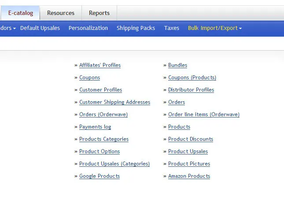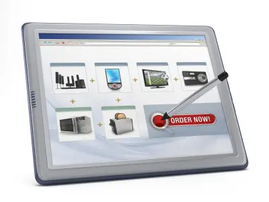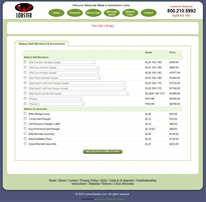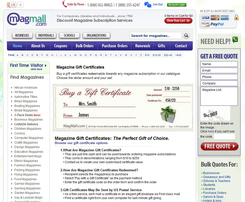
E-commerce solution Open Source Close Source Debate
In the world of developer’s and consultants supplying software to commercial clients, there have always been core issues which dictate the choice of one software solution over another. In the world of website development — more specifically eCommerce — the “core issues” which were once so numerous have now taken on a new wavelength - that of the open vs closed source software solution. What this article will set out to accomplish is to convey a more current understanding of the choices clients are evaluating and see if there is a 3rd alternative that can bridge the gap between the poles of what is currently seen as the only two choices.

Overview of Guiding Principles of B2B Web Site Design and Implementation
So you finally got promoted within your family owned business to take on the reigns of bringing your company's online web presence into the 21st century. If your company's experience is similar to many other businesses in its space - especially the manufacturing space - the odds are reasonable that you are sitting on what we call a "me too" website - just enough to complement your brand and logo and give people a way to connect with you but not much more. Considering our more than a decade of experience in managing companies' online web presence, the following is a summary of our step-by-step guide to designing a new high functioning b2b ecommerce site and moving beyond a simplistic brochure ware type of website. Read on as we dissect the challenge and give you some simple steps to look like a hero in a short amount of time.

Boosting an Ecommerce Business with Social Media
Big brands like Pepsi and McDonald’s, with tangible products and live locations, certainly aren’t the only companies out there benefiting from social media sites like Facebook. Ecommerce businesses are also doing quite well with Facebook.
Of course, ecommerce is unique in the sense that the transactions are taking place solely online, but once you break it down, you realize that it’s really an even playing field. Nobody is able to sell their products directly from a fan page; everybody is simply attempting to build awareness to boost their brand with the ultimate goal of increasing sales. And, yes, your ecommerce business can benefit from this too.

Configurable and Personalized Products – Complex Selling Made Simple
Offering customers the ability to configure and personalize products is an increasingly feasible and successful way to bolster sales. And it’s very popular among buyers — especially amid today’s “express-your-uniqueness” consumer mindset.
eCommerce platforms can now be designed to include product “Configurators”, which allow customers to define many features of a product before ordering it, and before it’s made. No longer is it just a few basic choices, but high-level, true customization and personalization to fit one’s personal style and taste. Color, material, size, measurements, inscriptions and insignia, finishes, embroidered text, monograms, graphics and logos are just a few of the countless variables that customers can specify when ordering a product.

Social Interaction and Online Visibility
In the U.S., social media is used by over half the population – 158 million people – a stunning new development in our culture and history. As such it poses a tremendous opportunity for ecommerce companies to connect with the market, create active dialogs around their brands, and develop rapport and familiarity before giving prospects a direct sales pitch. Wise use of social interaction is now a very effective way to condition the market, thus paving the way for sales.
Smart Ways Businesses use Social Networks – Here are just some of the ways today’s smart businesses are using social networks, social data, and interaction to deliver better products and services, and improve their bottom line

Managing Promotions within Your E-Commerce Platform
Selling products and services through online e-commerce affords many opportunities for effective promotions. In e-commerce any mechanism that aids in inducing a sale is a promotional tool. There are many different promotion types.

The Content Transfer and Migration Process
For managers responsible for web-site updates, one part of business website renovation keeps them awake at night: the transfer of legacy content from an existing site (or sites) to a newly developed site. Migrating content to a Content Management System (CMS) is a very important part of managing a business’ web presence. It is a difficult, time consuming, meticulous process and requires organizations to allocate significant resources, and train management teams in transfer issues.
Content accumulated over many years creates a maze of structured and unstructured data that can make the migration process potentially disruptive to ongoing operations. The objective of the process is high-performance web migration, which requires first that the parties have a clear vision of what must be accomplished through the migration, and that they then plan the steps necessary to implement the vision.

How Shipping and Delivery is Crucial to the E-Commerce Industry
For most online businesses, shipping can be one of the most difficult aspects of running an ecommerce site. Based on their experiences and observations of other sites, shipping costs and delivery time-frames are the biggest customer complaint that online retailers receive. A recent study confirms shipping to be one of the most important things to shoppers. Even if the shipping is free, customers often have obscene expectations on how fast their order will reach them. If it’s not free, there are always complaints about the cost even when the merchant directly passes down fees with no markup.

Streamline your ecommerce with the Right QuickBooks Integration Tools
QuickBooks has become an internal accounting fixture for a very large number of businesses. It is a solid bit of accounting software that businesses rely on very heavily to manage their operations, taxes, and financial information.
Today, many of the companies that have grown so reliant on QuickBooks have also developed, or are planning to develop, ecommerce platforms through which they conduct an increasingly large number of B2B or B2C business transactions. Still others are contemplating expanding to multiple online sales channels. Tracking all sales, customers, accounting, inventory and shipping in these circumstances can be daunting. While some can manage the separate online and local systems independently for a while, eventually it becomes necessary to merge the ecommerce transactions and related data into the QuickBooks system in a reliable, automated way so that accurate information is always at managers’ fingertips. Attaining the highest level of integration is important. Maximizing interface automation and efficiency has a direct impact on cost control.

Multi channels e-commerce management improvements by automation web store data exchange with back office applications
If your company conducts business online through an eCommerce application, and that eCommerce system runs independently of your other internal business-management software (for accounting, ERP, fulfillment, etc.), odds are very good that your organization is wasting a lot of time and money. Today, smart businesses recognize that integrating their online eCommerce systems with their internal operating software dramatically improves administrative efficiency and reduces costs.
Many business owners and managers may, however, hesitate to link these distinct systems together for fear of complication, confusion, or data loss. But, today such fears are unwarranted. Enterprises using “third party” software systems to manage their operations (like QuickBooks, Intuit’s accounting and financial-management suite) can and should secure the integration of data between their internal and eCommerce operating systems, for doing so is now possible and highly reliable with the right integration tools.

Social Media Become Vital Tool of E-Commerce Marketing
It is not a mystery that social media sites are excellent marketing tools for all types of businesses, but e-commerce sites have an advantage when it comes to using the different networks. For one, consider the e-commerce target market: online shoppers. People who spend their time on the Internet searching for products to buy are more than likely spending time on social media sites as well. This is just one reason why social media cannot be overlooked as a vital online visibility and marketing tool within the e-commerce industry.
Promoting products and services on sites such as Facebook, Twitter and blogs are a great way to drive consumers to your site and make sales. Social media outlets are good tools for link building and therefore by posting URLs that link back to your site, you are more likely to see an increase in traffic. Social media gives businesses the means to direct traffic to whichever site they want, whether it is a product giveaway on a blog site or a link to a coupon. E-commerce sites have an advantage over brick-and-mortar businesses because their consumers are just a click away from their products and do not have to travel into a store.

Web Solution: Dealers and Distributors Portal
More than ever before, business enterprises offering products or services seek effective tools to improve their interaction with a fast-paced marketplace, and increase sales. Fortunately, businesses today can efficiently utilize their online presence to enhance business interaction, accelerate growth, and keep up with the competition. Online portals designed to attract, enlist, and support distributors, dealers, and resellers, interact with customers, and manage sales transactions are becoming quite sophisticated, increasingly user-friendly, and capable of dramatically expanding the reach of any business, while increasing efficiency and lowering costs.

What is a Legacy Application or System?
Legacy applications are those that have grown over many years as an enterprise has developed, and they usually have unique features and capabilities essential to the business’ operation. As a result, they are difficult to replace or integrate with emerging modern systems and technologies. Organizations often run outdated web properties comprised of large collections of html pages built over long periods by many different people, or home-grown software, created by individuals no longer with the organization, with structures that no one knows enough about to feasibly add new elements. Some companies run large commercial systems that are very expensive to upgrade or that originated with vendors no longer serving the market. Still others use open-source systems like WordPress that, while simple to set up and use, don’t support the more advanced options required, or are very time consuming or expensive to modify or supplement.

The Utilization of Gift Certificates from an E-Commerce Perspective
For consumers, online shopping has benefits such as convenience and comparison. For companies, it gives the advantage of a national reach, builds loyalty and credibility and increases revenue. But how do companies maximize that revenue when it is easy to get lost on the web under the vast number of companies? Well, the easy answer is to become a client of any online store and use their technology to optimize your location on the web, streamline the navigation of your website, effectively promote your products and simplify the check out process. But if you don’t have time for such a large commitment, you should consider posting coupon codes.

Best Practices of Enterprise Blogging
Adrecom's
Enterprise Blogging Suite is a powerful engine that provides essential tools
for efficiently creating attractive, content-rich blogs that increase your
impact and reach. Adrecom’s blogging tools allow you to accommodate multiple
authors while synthesizing and organizing their posts, manage and pre-configure
social media interaction, pre-schedule posts, categorize posts, efficiently
link to related posts, and automatically moderate blog responses.
But, content is
still king. What you say and how you say it have everything to do with whether
your blog succeeds in its mission. Having the right blogging tools can take
your content to another level.